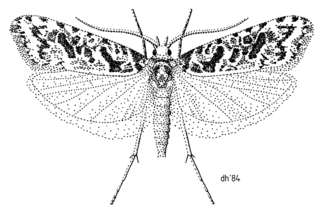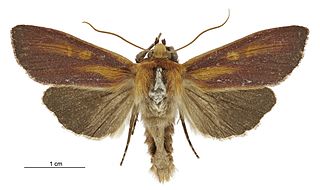
Ichneutica is a genus of cutworm or dart moths in the family Noctuidae, found in New Zealand and surrounding islands. There are more than 80 described species in Ichneutica, the largest known genus of Lepidoptera in New Zealand. In 2019 this genus was revised and greatly expanded with the genera Graphania Hampson, 1905, Tmetolophota Hampson, 1905 and Dipaustica Meyrick, 1912 all subsumed within it.
Stigmella propalaea is a species of moth in the family Nepticulidae. It is endemic to New Zealand. This species is classified as "Data Deficient" by the Department of Conservation.

Heterocrossa eriphylla, also known as the lichen snoutlet moth, is a species of moth in the family Carposinidae. It is endemic to New Zealand. The larvae of this species feed on the healing wounds of New Zealand beech trees.
Heterocrossa gonosemana is a species of moth in the family Carposinidae. It is endemic to New Zealand.

Circoxena ditrocha is a species of moth in the family Blastodacnidae. This species is endemic to New Zealand. It is classified as "At Risk, Naturally Uncommon" by the Department of Conservation.

Tmetolophota blenheimensis is a species of moth in the family Noctuidae. It is endemic to New Zealand. It is classified as "At Risk, Naturally Uncommon" by the Department of Conservation.

Ichneutica purdii, the orange astelia wainscot, is a moth of the family Noctuidae. It is endemic to New Zealand. It can be found throughout the main islands of New Zealand. I. purdii is a relatively large, colourful moth, unlikely to be confused with any other endemic moth species in New Zealand. The larvae of this moth feed at night on species of Astelia. During the day they shelter in the interior of the plant. When fully grown the larvae can reach a length of approximately 48mm. The larvae are ocherous in colour with a pink flush with line markings but when ready to pupate these markings fade and the larvae take on a light golden hue with a rosy tinge to its rear segments. The deep wine coloured pupa is enclosed in a slight cocoon, with this being constructed below the soil, amongst debris or alternatively within a hollow stick. The adult moths are on the wing from October to March. Although this moth is found throughout the main islands of New Zealand it is more frequent in the south of New Zealand at higher altitudes of up to 1200m.
Schiffermuelleria orthophanes is a moth of the family Oecophoridae. It is endemic to New Zealand. It is classified as critically endangered by the Department of Conservation.
Erechthias lychnopa is a species of moth in the family Tineidae. This species is endemic to New Zealand. It is classified as "Data Deficient" by the Department of Conservation.
Microcolona limodes is a species of moth in the family Elachistidae. It is endemic to New Zealand. The larvae of this moth eat the seeds of endemic Myrsine species.

Meterana pansicolor is a species of moth in the family Noctuidae. It is endemic to New Zealand. This species is classified as "At Risk, Naturally Uncommon" by the Department of Conservation.

Aletia dentata is a moth in the family Noctuidae. It is endemic to New Zealand.

Aletia fibriata is a moth in the family Noctuidae. It is endemic to New Zealand. Specimens of this moth were first collected by Frederick Giles Gibbs. Adults frequent alpine areas at about 4,500 feet and are on the wing in December.

Hierodoris stella is a species of moth in the family Oecophoridae. This species is endemic to New Zealand. It is classified as "At Risk, Relict'" by the Department of Conservation.
Aletia cyanopetra is a species of moth in the family Noctuidae. It is endemic to New Zealand. It is classified as "Data Deficient" by the Department of Conservation.

Aletia argentaria is a species of moth in the family Noctuidae. It is endemic to New Zealand and can be found in Southland.

Nivetica nervosa is a moth of the family Noctuidae. It is only found in New Zealand. This species can be found in wetland habitat in the alpine zone of the South Island. It is a small, distinctively patterned moth that is attracted to light. Currently much of its biology and life cycle is unknown.

Ichneutica ceraunias is a moth of the family Noctuidae. It is endemic to New Zealand. This species is found from the central North Island to the bottom of the South Island. Hosts of the larvae are species of Chionochloa and Festuca. This colourful moth is variable in appearance and can be mistaken for Ichneutica dione. Adults are on the wing from October to February.

Ichneutica dione is a moth of the family Noctuidae. It is endemic to New Zealand.

Ichneutica cana is a moth of the family Noctuidae. It is endemic to New Zealand.
















